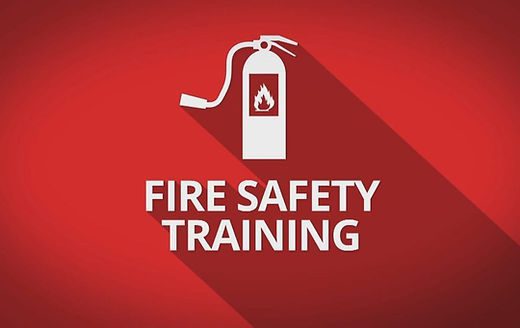Contents
- 1 Understanding Fire Safety Certification
- 2 The Importance of Fire Safety Certification
- 3 Exploring Different Types of Fire Safety Certifications
- 4 Key Benefits of Obtaining Fire Safety Certification
- 5 The Role of Fire Safety Inspections in Certification Process
- 6 Essential Fire Safety Equipment and Systems for Certification
- 7 Fire Safety Training: Enhancing Preparedness and Response
- 8 Ensuring Compliance with Fire Codes and Regulations
- 9 Steps to Obtaining Fire Safety Certification for Your Business
- 9.1 Step 1: Understand Local Regulations
- 9.2 Step 2: Conduct a Fire Risk Assessment
- 9.3 Step 3: Implement Fire Safety Measures
- 9.4 Step 4: Establish Emergency Response Plans
- 9.5 Step 5: Schedule Fire Safety Inspections
- 9.6 Step 6: Address Inspection Findings
- 9.7 Step 7: Submit Required Documentation
- 9.8 Step 8: Maintain Regular Inspections and Updates
- 10 Maintaining Fire Safety Certification: Regular Inspections and Updates
Fire safety certification is a vital component in maintaining a secure environment. Whether it’s a residential building, commercial establishment, or industrial facility, ensuring proper fire safety measures is crucial for the safety and well-being of occupants. In this article, we will explore the importance of fire safety certification, the benefits it offers, and the steps involved in obtaining it. By understanding the significance of this certification, you can take proactive measures to protect lives and property from the devastating effects of fire hazards.
Understanding Fire Safety Certification
Fire safety certification is a crucial aspect of maintaining a safe and secure environment. It ensures that a building or facility has implemented the necessary measures to prevent, detect, and respond to fire hazards effectively. Understanding the ins and outs of fire safety certification is essential for property owners, facility managers, and individuals responsible for ensuring the safety of occupants.
Obtaining fire safety certification requires adherence to specific guidelines and regulations set forth by local authorities. It involves a comprehensive evaluation of a building’s fire prevention systems, emergency preparedness plans, and overall safety protocols. The certification process typically includes inspections, documentation review, and verification of compliance with fire codes.
The Importance of Fire Safety Measures
Effective fire safety measures are vital for protecting lives, property, and the environment. Fires can cause devastating consequences, resulting in injuries, fatalities, and significant damage. Implementing proper fire safety measures reduces the risk of fire incidents and ensures timely response in case of emergencies.
Fire safety measures encompass various aspects, including fire prevention, detection, suppression, and evacuation procedures. They involve installing and maintaining fire alarm systems, fire extinguishers, sprinkler systems, emergency lighting, and exit signs. Additionally, regular fire drills, training programs, and awareness campaigns are essential for educating occupants and promoting a safety-conscious culture.
The Importance of Fire Safety Certification
Fire safety certification plays a crucial role in ensuring the overall safety and well-being of occupants in any building or facility. Here are some key reasons why obtaining fire safety certification is of utmost importance:
Legal Compliance
Fire safety certification is often a legal requirement imposed by local authorities. It ensures that buildings and facilities meet the necessary safety standards and comply with fire codes and regulations. Failure to obtain certification can result in penalties and even closure of the premises.
Enhanced Safety Measures
Obtaining fire safety certification goes beyond mere compliance; it demonstrates a commitment to maintaining the highest safety standards. It encourages property owners and managers to implement robust fire prevention measures, install proper safety equipment, and establish effective emergency response protocols.
Occupant Safety
Fire safety certification directly impacts the safety of occupants. It ensures that the building or facility is equipped with adequate fire suppression systems, alarm systems, and emergency exits. This certification instills confidence in occupants, assuring them that the necessary measures are in place to protect their lives in the event of a fire.
Reduced Property Damage
By implementing fire safety measures and obtaining certification, the risk of fire-related property damage is significantly reduced. Timely detection, effective suppression, and well-executed evacuation plans can minimize the impact of fires, potentially saving valuable assets and reducing financial losses.
Insurance Requirements
Fire safety certification is often a prerequisite for obtaining insurance coverage. Insurance companies assess the level of fire risk associated with a building before providing coverage. Having proper certification demonstrates that the necessary precautions have been taken, potentially resulting in more favorable insurance rates.
Exploring Different Types of Fire Safety Certifications
Fire safety certifications come in various forms, each serving specific purposes and catering to different types of buildings and facilities. Here are some common types of fire safety certifications:
Fire Safety Certificate
A fire safety certificate is a document issued by the local fire authority after a thorough assessment of a building’s fire safety measures. It confirms that the building complies with fire codes and regulations and has adequate fire prevention and suppression systems in place.
Fire Risk Assessment
A fire risk assessment is an evaluation conducted to identify potential fire hazards and assess the level of risk associated with a building or facility. It helps determine appropriate fire safety measures and serves as a foundation for developing emergency response plans.
Fire Warden Certification
Fire warden certification is designed for individuals responsible for overseeing fire safety within a building or facility. Fire wardens undergo training to understand fire hazards, evacuation procedures, and fire extinguisher usage. Certification ensures they have the knowledge and skills to effectively carry out their responsibilities.
Sprinkler System Certification
Buildings equipped with automatic sprinkler systems may require a separate certification to ensure the proper functioning and maintenance of the system. Certification involves regular inspections, testing, and verification that the sprinkler system meets industry standards.
Fire Alarm System Certification
Similar to sprinkler systems, fire alarm systems may require certification to ensure they are operational and meet the necessary standards. Certification involves testing the system components, including smoke detectors, control panels, and alarm notification devices.
It’s important to determine the specific certifications relevant to your building or facility based on local regulations, building type, and occupancy. Consulting with fire safety professionals or local authorities can help identify the appropriate certifications required.
Key Benefits of Obtaining Fire Safety Certification
Obtaining fire safety certification offers numerous benefits for both property owners and occupants. Here are some key advantages of obtaining this certification:
Enhanced Safety Preparedness
Fire safety certification ensures that a building or facility is adequately prepared to handle fire emergencies. It requires the implementation of comprehensive fire prevention measures, emergency response plans, and regular training for occupants. This enhances overall safety preparedness and reduces the risk of injuries or fatalities in the event of a fire.
Compliance with Regulations
Fire safety certification ensures compliance with local fire codes and regulations. By obtaining certification, property owners demonstrate their commitment to meeting the necessary safety standards and adhering to legal requirements. This helps avoid penalties and legal issues associated with non-compliance.
Improved Reputation and Trust
Buildings and facilities with fire safety certification earn a reputation for prioritizing the safety and well-being of their occupants. This enhances the trust and confidence of residents, employees, and visitors, knowing that the necessary measures are in place to protect them in case of a fire incident.
Potential Insurance Benefits
Insurance companies often consider fire safety certification when determining coverage and premium rates. Having proper certification can result in more favorable insurance terms and potentially lower premiums. It demonstrates to insurers that proactive measures have been taken to mitigate fire risks.
Reduced Property Damage
Fire safety measures, as required for certification, significantly reduce the risk of property damage in case of a fire. Early detection systems, effective suppression methods, and well-maintained safety equipment minimize the spread of fire, potentially saving valuable assets and reducing costly repairs or replacements.
Overall, obtaining fire safety certification provides peace of mind for property owners, occupants, and stakeholders. It ensures a safer environment, legal compliance, and various other benefits that contribute to the overall well-being and protection of individuals and property.
The Role of Fire Safety Inspections in Certification Process
Fire safety inspections play a crucial role in the certification process, ensuring that buildings and facilities meet the necessary safety standards. These inspections are conducted by authorized personnel, such as fire department officials or certified fire safety inspectors. Here’s an overview of the key aspects of fire safety inspections:
Comprehensive Evaluation
During a fire safety inspection, the inspector assesses various aspects of a building’s fire safety measures. This includes evaluating fire prevention systems, such as fire alarms, sprinkler systems, and fire extinguishers, as well as the overall condition of the building’s fire exits, evacuation routes, and emergency lighting.
Identification of Hazards
The inspector identifies potential fire hazards or risks within the building, such as flammable materials, faulty electrical systems, or inadequate fire barriers. These hazards are documented, and recommendations are made to address and mitigate them to ensure a safer environment.
Verification of Compliance
The inspector verifies that the building or facility meets the necessary fire codes and regulations. This includes ensuring that the fire safety measures implemented comply with the local regulations and industry standards. Any non-compliance issues are identified and communicated to the property owner or manager for rectification.
Documentation Review
Fire safety inspections involve a thorough review of documentation, including maintenance records, testing reports, and fire safety plans. The inspector ensures that all necessary documentation is up to date, accurate, and readily available for reference in case of an emergency.
Recommendations and Follow-up
Based on the inspection findings, the inspector provides recommendations for improvements and necessary corrective actions. These recommendations may include upgrading fire safety equipment, conducting additional training, or implementing better emergency response protocols. A follow-up inspection may be scheduled to ensure that the recommended actions have been taken.
Fire safety inspections are instrumental in the certification process, as they help identify potential risks, ensure compliance, and provide guidance for enhancing fire safety measures. Regular inspections are essential to maintain certification and to continually improve the overall fire safety of a building or facility.
Essential Fire Safety Equipment and Systems for Certification
Obtaining fire safety certification requires the implementation of essential equipment and systems to prevent, detect, and respond to fire hazards effectively. Here are some key components that play a crucial role in achieving certification:
Fire Alarm Systems
Fire alarm systems are a cornerstone of fire safety. They consist of smoke detectors, heat detectors, and manual pull stations that trigger an audible and visual alarm when smoke or heat is detected. These systems provide early warning to occupants, enabling them to evacuate promptly.
Fire Suppression Systems
Fire suppression systems are designed to control or extinguish fires automatically. They can include sprinkler systems, which release water when a certain temperature is reached, or specialized systems like clean agent suppression systems that use gases or chemicals to suppress fires without water damage.
Fire Extinguishers
Portable fire extinguishers are crucial for initial fire response before the arrival of professional firefighters. They come in different types, such as water, foam, CO2, or dry chemical extinguishers, each suitable for specific types of fires. Proper placement, maintenance, and regular inspections of fire extinguishers are essential for certification.
Emergency Lighting
During a fire emergency, visibility can be significantly reduced due to smoke or power outages. Emergency lighting systems, including exit signs and illuminated pathways, provide clear guidance to occupants, enabling them to navigate safely towards exits and evacuation routes.
Fire Doors and Fire-rated Partitions
Fire doors and fire-rated partitions are designed to prevent the spread of fire and smoke within a building. They provide compartmentalization, creating barriers that limit the fire’s ability to move from one area to another. These components are crucial for certification, and their proper installation and maintenance are necessary.
Emergency Evacuation Plans
Having well-defined emergency evacuation plans is essential for fire safety certification. These plans outline procedures for evacuating occupants, including designated assembly areas, communication methods, and responsibilities of designated personnel. Regular drills and training ensure that occupants are familiar with the evacuation procedures.
Implementing and maintaining these essential fire safety equipment and systems are crucial for obtaining and maintaining fire safety certification. They are designed to prevent fires, facilitate early detection, suppress fires, and ensure safe evacuation, contributing to an overall safer environment for occupants.
Fire Safety Training: Enhancing Preparedness and Response
Fire safety training is a vital component of achieving and maintaining fire safety certification. It equips individuals with the knowledge, skills, and confidence to respond effectively in a fire emergency. Here’s why fire safety training is essential:
Understanding Fire Hazards
Fire safety training educates individuals about the common causes of fires, such as electrical malfunctions, improper use of flammable materials, or human error. It helps raise awareness about potential fire hazards in different environments, enabling individuals to identify and mitigate risks.
Fire Prevention Measures
Training programs emphasize the importance of fire prevention measures, such as proper storage and handling of flammable materials, regular maintenance of electrical systems, and safe usage of appliances. By implementing preventive practices, individuals can significantly reduce the likelihood of fire incidents.
Emergency Response Procedures
Fire safety training provides individuals with clear guidance on emergency response procedures. This includes knowing how to activate fire alarms, evacuate safely, use fire extinguishers, and assist others in need. Training also covers communication protocols, ensuring effective coordination during an emergency.
Evacuation Drills and Practice
Regular evacuation drills are an integral part of fire safety training. These drills simulate emergency situations, allowing individuals to practice evacuating quickly and efficiently. By participating in drills, individuals become familiar with evacuation routes, assembly areas, and the importance of remaining calm during an evacuation.
Training for Fire Wardens
Fire safety training often includes specialized training for designated fire wardens or marshals. These individuals receive comprehensive instruction on their roles and responsibilities, including conducting evacuations, performing headcounts, and ensuring the overall safety of occupants during a fire emergency.
Periodic Refresher Training
Fire safety training should be an ongoing process. Periodic refresher training ensures that individuals stay updated on best practices, equipment usage, and any changes in emergency response protocols. Regular training reinforces knowledge and helps maintain a culture of fire safety consciousness.
Fire safety training is a critical investment in enhancing preparedness and response capabilities. By equipping individuals with the necessary knowledge and skills, it contributes to a safer environment, reduces the risk of injuries or fatalities, and increases the overall effectiveness of emergency response efforts.
Ensuring Compliance with Fire Codes and Regulations
Compliance with fire codes and regulations is a fundamental requirement for obtaining fire safety certification. These codes are established by local authorities and aim to ensure the safety of buildings and occupants. Here’s why adhering to fire codes and regulations is crucial:
Legal Obligation
Fire codes and regulations are legally binding requirements that must be followed. Non-compliance can result in penalties, fines, and legal consequences. By adhering to these regulations, property owners demonstrate their commitment to maintaining a safe environment.
Safety Standards
Fire codes and regulations are designed to establish minimum safety standards for buildings and facilities. They specify requirements for fire prevention systems, emergency exits, occupancy limits, electrical installations, and more. Compliance with these standards ensures that appropriate safety measures are in place.
Fire Prevention and Protection
Fire codes and regulations focus on preventing fires and protecting occupants in case of emergencies. They dictate the installation and maintenance of fire alarm systems, sprinkler systems, fire extinguishers, and other fire safety equipment. Compliance with these regulations enhances the overall fire safety of a building or facility.
Occupant Well-being
Adhering to fire codes and regulations directly impacts the well-being of occupants. These regulations ensure that buildings have sufficient emergency exits, clear evacuation routes, and properly maintained fire safety equipment. Compliance provides occupants with a higher level of safety and peace of mind.
Insurance Requirements
Insurance companies often require compliance with fire codes and regulations as a condition for coverage. By meeting these requirements, property owners may qualify for insurance policies with better terms and lower premiums. Compliance demonstrates a commitment to risk management and loss prevention.
Professional Guidance
Consulting with fire safety professionals, inspectors, or local authorities is essential for understanding and ensuring compliance with fire codes and regulations. These professionals have the expertise to assess a building’s compliance, identify areas for improvement, and provide guidance on achieving and maintaining compliance.
Ensuring compliance with fire codes and regulations is essential for obtaining fire safety certification. It establishes a foundation for maintaining a safe environment, protecting occupants, and minimizing the risk of fire incidents and their potential consequences.
Steps to Obtaining Fire Safety Certification for Your Business
Obtaining fire safety certification for your business involves a series of steps to ensure compliance with fire codes and regulations. Here is a breakdown of the key steps involved in the certification process:
Step 1: Understand Local Regulations
Familiarize yourself with the specific fire codes and regulations applicable to your location. Research and understand the requirements set forth by the local fire department or other relevant authorities.
Step 2: Conduct a Fire Risk Assessment
Engage a professional fire safety consultant to conduct a thorough fire risk assessment of your premises. This assessment will identify potential fire hazards, assess the level of risk, and determine the necessary fire safety measures to implement.
Step 3: Implement Fire Safety Measures
Based on the findings of the fire risk assessment, implement the recommended fire safety measures. This may include installing fire alarm systems, fire extinguishers, emergency lighting, and other essential equipment as specified by the regulations.
Step 4: Establish Emergency Response Plans
Develop comprehensive emergency response plans that outline evacuation procedures, designated assembly areas, communication protocols, and the roles and responsibilities of staff members during a fire emergency. Ensure that all employees are trained on these plans.
Step 5: Schedule Fire Safety Inspections
Contact the local fire department or certified fire safety inspectors to schedule an inspection of your premises. They will assess your compliance with fire codes and regulations, inspect your fire safety equipment, and review documentation related to maintenance and testing.
Step 6: Address Inspection Findings
If any deficiencies or non-compliance issues are identified during the inspection, promptly address them to ensure compliance. This may involve repairing or replacing equipment, updating documentation, or making necessary modifications to the premises.
Step 7: Submit Required Documentation
Compile all the necessary documentation, including inspection reports, maintenance records, emergency response plans, and any other required paperwork. Submit these documents to the appropriate authorities to complete the certification process.
Step 8: Maintain Regular Inspections and Updates
Once you have obtained fire safety certification, it is important to maintain it by conducting regular inspections, testing equipment, and keeping documentation up to date. Stay informed about any changes in regulations and ensure ongoing compliance.
By following these steps, you can navigate the process of obtaining fire safety certification for your business. Certification demonstrates your commitment to ensuring a safe environment for employees, customers, and visitors, while also aligning with legal requirements and industry standards.
Maintaining Fire Safety Certification: Regular Inspections and Updates
Maintaining fire safety certification is crucial for ensuring ongoing compliance with fire codes and regulations. It involves regular inspections and updates to ensure that your building or facility continues to meet the necessary safety standards. Here are some key considerations for maintaining fire safety certification:
Regular Inspections
Schedule regular inspections to assess the condition of your fire safety equipment and systems. Engage certified fire safety inspectors or professionals to conduct thorough inspections and identify any issues or deficiencies that need to be addressed.
Testing and Maintenance
Adhere to the recommended testing and maintenance schedules for your fire safety equipment, such as fire alarms, sprinkler systems, and fire extinguishers. Regularly test these systems to ensure they are functioning properly and perform any necessary maintenance or repairs promptly.
Documentation Management
Maintain accurate and up-to-date documentation related to your fire safety measures, including inspection reports, testing records, maintenance logs, and certifications. Keep these documents organized and easily accessible for reference during inspections or in case of emergencies.
Stay Informed About Regulations
Stay updated on any changes or updates to fire codes and regulations that may affect your certification. Regularly review local regulations and industry standards to ensure ongoing compliance and make any necessary adjustments to your fire safety measures accordingly.
Employee Training and Awareness
Continuously educate your employees about fire safety procedures, evacuation plans, and the proper use of fire safety equipment. Conduct regular fire drills and training sessions to reinforce their knowledge and ensure that they are prepared to respond effectively in case of a fire emergency.
Addressing Non-Compliance Issues
If any non-compliance issues are identified during inspections or through self-assessment, address them promptly and thoroughly. Take corrective actions to rectify deficiencies, ensure compliance, and document the steps taken to demonstrate your commitment to maintaining a safe environment.
By prioritizing regular inspections, testing, and ongoing maintenance, you can ensure that your fire safety certification remains valid and up to date. This commitment to maintaining a safe environment not only helps protect lives and property but also reinforces trust and confidence among occupants and stakeholders.
In conclusion, fire safety certification is a crucial aspect of maintaining a safe and secure environment. By understanding the importance of fire safety measures, exploring different types of certifications, and implementing the necessary equipment and systems, you can enhance the overall safety of your building or facility. Adhering to fire codes and regulations, conducting regular inspections, and staying updated on industry standards play a vital role in obtaining and maintaining certification. Fire safety training and maintaining documentation further contribute to preparedness and compliance. Remember, fire safety is a collective responsibility, and by prioritizing certification, you prioritize the well-being and safety of occupants. Stay proactive, stay informed, and stay committed to fire safety certification for a secure environment.

Passionate about preserving lives and protecting properties, John Sarver is a dedicated advocate for fire safety. With an unwavering commitment to educating and empowering communities, he has become a prominent voice in the field. As the founder and author of the influential blog “SarverFire,” John’s mission is to share invaluable insights, tips, and resources to enhance fire safety awareness and preparedness.





